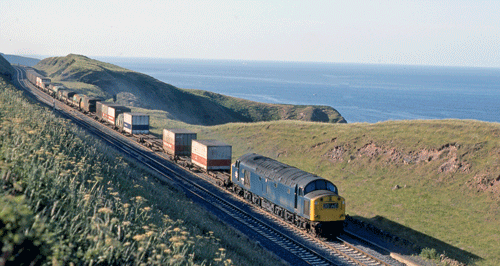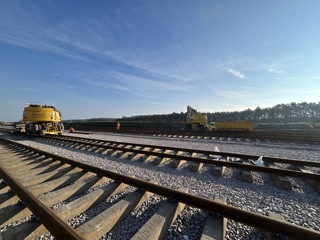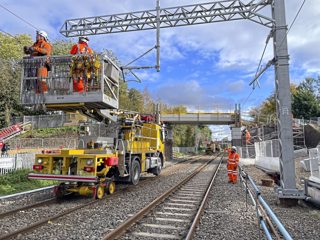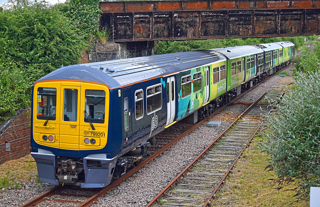While Dr Beeching is rarely remembered as a promoter of rail freight, one of the recommendations in his infamous 1963 report The Reshaping of British Railways was the setting up of a national network of liner trains, designed to replace the then archaic wagonload system.
The Doctor envisaged a network of up to 55 depots spread across the country, stretching from Plymouth and Brighton to Glasgow and Aberdeen. The average length of the rail haul was expected to be 150 miles, but some trains would cover as little as 70 miles. Annual carryings were projected to reach 57 million tons by 1984.
Although the idea of carrying containers by rail wasn’t new - small containers were being carried on Conflat wagons as long ago as the 1930s - the new liner trains would be the first to consist of permanently coupled wagon sets, with fixed bar couplings within each set, and they would be fitted with air instead of vacuum brakes.
Each wagon would have a deck length of 40ft, later amended to 60ft. The containers would be designed to international standards - 8ft wide and up to 8ft high, with standard lengths ranging from 10ft to 27ft (later adjusted to 30ft).
Shildon Works outshopped a prototype set of liner wagons in January 1964, and Ashford followed this up with the first production order of 100 wagons later the same year. The Freightliner brand name was soon adopted, and the first revenue-earning Freightliner trains ran between York Way (also known as Maiden Lane) in north London and Glasgow Gushetfaulds on November 15 1965.
The launch wasn’t without its problems: the National Union of Railwaymen had objected to the use of private road hauliers at the rail depots, and refused to let guards travel in the rear cab of the locomotive. The first objection was overcome just in time for the launch, but the second issue took longer to resolve - for a time Freightliner trains ran with a guards van at the rear.
The Freightliner network grew quickly, and by mid-1968 liner trains were serving 17 purpose-built depots, located in major population centres across the country. British Rail also ran Freightliner trains to and from non-Freightliner terminals - these included services between Camden Goods and Heysham Port, the ‘Tartan Arrow’ train between Kentish Town and Glasgow Bridgeton, and a short-lived service between Park Royal, Plymouth and Par. From 1968 until 1970 BR even ran a Freightliner train between Stratford and Paris, with the wagons crossing the Channel on the Dover-Dunkerque ferry.
Under the 1968 Transport Act, Freightliner was established as a separate company from BR, operating as part of the National Freight Corporation. Freightliner took ownership of BR’s International Standards Organisation (ISO) containers, but leased the wagons and terminals from BR, which also continued to provide diesel and electric traction.
The network of container trains continued to grow, with 28 terminals and 56 routes in operation by the end of 1969. New regional depots included those at Nottingham, Swansea, Trafford Park and Birmingham Landor Street - the last two supplemented the existing facilities at Longsight and Dudley respectively.
The Beeching vision for Freightliner had focused on domestic distribution, but in the early 1970s the potential for maritime traffic began to be realised.
Already the Irish market had been served via Heysham and Holyhead, since 1967/68 Freightliner had reached the East Coast ports of Harwich and Felixstowe (albeit without a dedicated terminal in the latter case), and the depot at Southampton Millbrook was handling more and more deep-sea traffic. But a new generation of terminals placed the emphasis very clearly on the sea - Tilbury opened in 1970, and both Felixstowe South and Southampton Maritime opened in 1972.
Freightliner’s inland terminals became increasingly geared to maritime traffic. A new terminal at Barking Ripple Lane was opened in 1972 for specific flows, including two daily services to and from Southampton for shipping lines OCL and ACT. A mini-terminal was established at Swindon to receive trainloads of Anchor butter from Tilbury. And the opening of Coatbridge Freightliner terminal in 1968 was largely intended for the deep-sea market, with train services contracted by OCL. Overall, the proportion of deep-sea containers on Freightliner trains rose from 13% in 1970 to 42% in 1980.
Freightliner also worked hard to develop its Irish traffic via Holyhead, which had been temporarily diverted to a makeshift railhead at Caernarfon between 1970 and 1972 because of the Menai Bridge fire.
The Irish business included two types of ‘land bridge’ traffic: deep-sea containers routed via Birmingham, and European traffic to and from Harwich. Freightliner operated its own terminals in both Belfast and Dublin, and for a time the Irish rail operator Córas Iompair Éireann provided a connecting rail service from the quayside in Dublin.
Notable domestic successes for Freightliner in the 1970s included aluminium from Rogerstone in South Wales (loaded at Cardiff Pengam), and substantial Post Office business on various routes. On the debit side, Freightliner closed its Sheffield terminal because of dwindling traffic volumes - largely the result of the declining stainless steel industry, coupled with improvements to the motorway network in south Yorkshire.
Further investment in the deep-sea business included the opening in 1978 of the Northfleet Hope terminal at Tilbury, reached by a spur from Freightliner’s own Tilbury terminal.
In the same year, the Department of Transport (as it was then known) made a £412,000 Section 8 Grant towards the cost of a rail container terminal at Seaforth Dock, Liverpool. This project included two miles of new track and gave a welcome boost to rail freight in Liverpool at a time when conventional wagon traffic to and from the port had ceased completely.
The trend towards taller maritime containers presented a problem for Freightliner because of the restricted loading gauge on most parts of the BR network. A major investment scheme to allow 8ft 6in boxes to be carried on the East Coast Main Line (ECML) involved lowering the track in Stoke, Peascliffe and Penmanshiel tunnels. The work was successfully completed at Stoke and Peascliffe, but Penmanshiel Tunnel collapsed during the project and the railway had to be rebuilt around the tunnel on a new alignment. Ironically Freightliner would later withdraw its services on that stretch of the ECML.
As the 1970s drew to a close, another change of direction was heralded as the 1978 Transport Act brought control of Freightliner back to the British Railways Board. This change was welcomed by many, although it also meant that Freightliner was no longer eligible to apply for Section 8 Grant funding to upgrade its own facilities.
Meanwhile, the shift from domestic to deep-sea traffic continued. Felixstowe experienced particularly rapid growth, and in 1983 the port doubled its Freightliner capacity by opening a second rail terminal (Felixstowe North). Initially, the new facility was reached by an internal dock railway from the throat of Felixstowe South, but in 1987 British Rail opened a new 1¼-mile spur from Trimley station to Felixstowe North, leading to slicker operations. Alongside its deep-sea throughput, Felixstowe handled European containers in place of Harwich from late 1985 onwards.
Domestic Freightliner traffic stagnated in the 1980s, but there were some notable successes in niche markets. In 1984 Freightliner started moving large quantities of aluminium billet from Newport to Falkirk, routed via its Cardiff to Coatbridge service. In the same year it renewed its contract with Royal Mail for parcels between London, northeast England and Scotland.
However, the overall picture for inland terminals was mixed, with those that relied on domestic business suffering a decline. Even the recently connected port terminal at Seaforth had its service cut to a single daily train to and from nearby Garston. The problem with Seaforth was that many of its customers were located in northern England and the Midlands, too close to the port for rail transport to be viable.
It soon became clear that Freightliner’s future lay in enhancing its core routes, with longer and more frequent trains serving a smaller number of regional terminals. The cull of marginal depots began in 1986 with the closure of King’s Cross (which latterly handled only a nightly Freightliner service to and from Edinburgh) and Dudley (whose traffic could easily be subsumed by Birmingham Landor Street). In the same year the privately operated depots at Aintree and Greenock closed.
In April 1987 Freightliner jettisoned eight further depots: Aberdeen, Dundee, Edinburgh, Newcastle, Hull, Longsight, Nottingham and Swansea. The closure of three Scottish terminals was perhaps surprising because of their potential for long-distance trains, but Freightliner preferred to use road connections to and from Coatbridge, which lay at the end of the electrified West Coast Main Line.
The rearrangement of BR into business sectors in the late 1980s brought Freightliner under the control of Railfreight Distribution (RfD), the non-bulk arm of the BR freight business. Operationally, most Freightliner trains continued to run separately from other freight flows - the only route where Freightliner regularly shared haulage with other RfD traffic was between Bristol and Coatbridge, where two Freightliner flats were attached to scheduled Speedlink services.
Under RfD management specific traction pools were allocated to Freightliner traffic for the first time. In May 1988 the Freightliner stock list comprised ten Class 08 shunters, three Class 31 diesels, 27 Class 37 diesels and 29 Class 47 diesels, together with 26 assorted AC electrics (mainly Class 86, but also including some examples of Classes 81, ‘85’, ‘87’ and ‘90’). Gradually the fleet would become more standardised, with the Class 31s and older electrics phased out.
In 1989 Freightliner’s poorly-sited Stockton depot was replaced by a new terminal at Wilton, financed partly by a European grant. Wilton was located within ICI’s Teesside complex - this was useful not only because ICI was Freightliner’s biggest customer in the region, but also because containers could be transported between the rail terminal and local ICI installations without using public roads, which were then subject to a 38-tonne weight restriction.
At the start of the 1990s Freightliner faced an uncertain future, as plans were laid for railway privatisation. Two particular challenges loomed: the first was the need to replace the Freightliner wagon fleet, which was nearing the end of its useful life; the second was to accommodate the growing number of 8ft 6in and 9ft high containers that were landing at Britain’s deep-sea ports.
The wagon supply issue was alleviated when BR ordered 700 new intermodal flats from Arbel Fauvet, with the first deliveries in 1991. The new wagons were semi-permanently coupled in two- and three-wagon sets, which gave the operator greater flexibility compared with the five-wagon sets of first-generation stock. Freightliner also started hiring single flat wagons from Tiphook. These were particularly useful for carrying Freightliner traffic on non-Freightliner routes, such as paper from Corpach and aluminium from Fort William.
While the new standard flats and the Tiphook hire-ins could carry 8ft 6in containers on key routes such as the West Coast Main Line, other solutions had to be found for conveying 9ft containers on those routes and for conveying 8ft 6in boxes on more heavily restricted routes.
During 1990 rakes of ‘Multifret’ wagons hired from the French operator SNCF were trialled. As well as providing a lower deck for high containers, the ‘Multifrets’ were designed for 90mph operation, compared with the normal 75mph maximum speed of Freightliner trains.
A longer-lasting solution for carrying taller containers was the fleet of 45 ‘Lowliner’ wagons that entered service with Freightliner in summer 1991. With their deck height of just 720mm above rail level, compared with 980mm for a standard second-generation wagon, the ‘Lowliners’ could carry 9ft 6in boxes on those routes cleared for 8ft 6in containers on conventional wagons.
However, in their early years the main role of the ‘Lowliners’ was to carry 8ft 6in containers within the tight clearances of former South Eastern & Chatham Railway lines in north Kent, a job that became necessary when Freightliner began serving the new deep-water container port of Thamesport. A temporary railhead was provided at Thamesport in 1991, followed by a permanent facility in March 1993.
In the Irish market, Freightliner’s 23-year association with the North Wales Coast Line ended in March 1991, when Sealink withdrew its freight sailings from Holyhead to Dublin and Belfast. Initially all Irish Freightliner traffic was diverted to run via Ellesmere Port, using the former Cawoods railhead on the docks branch. It was later switched to Seaforth, until volumes shrank so much that Freightliner withdrew from the market.
As railway privatisation drew closer, BR subjected the Freightliner network to a detailed review in an effort to improve Freightliner’s financial performance. The RfD division, of which Freightliner was a part, was regarded as the weak link in the BR portfolio, even after the closure of the heavily loss-making Speedlink wagonload network in July 1991. Freightliner itself was an unattractive proposition to potential buyers.
The review resulted in a revamped timetable from May 1992, followed by some fine-tuning in January and May 1993. Freightliner reduced the number of direct trains between terminals, and gave Crewe Basford Hall yard an enhanced role as a portion exchange point for deep-sea traffic. Daily services operated between Crewe and all UK Freightliner terminals, so that almost any itinerary was possible with just one change of train. This change led to more efficient locomotive diagramming, with fewer examples of diesel traction running long distances under the wires.
Those parts of the Freightliner network that catered for non-maritime traffic came under increasing pressure as domestic traffic volumes dropped. The two main London terminals were vulnerable because the city was too close to the deep-sea ports for the use of rail to be viable.
The decline of Willesden was particularly dramatic - from handling 11 daily Freightliner departures in 1989 its throughput fell rapidly and it faced complete closure in 1992. Stratford lasted a little longer, before its residual business was switched to the maritime terminal at Tilbury in 1994.
Further casualties of the reduced domestic business were Bristol (closed in 1992) and Glasgow Gushetfaulds, whose remaining traffic was transferred to Coatbridge in 1993. In Manchester, the original Trafford Park Freightliner terminal was mothballed in 1993 and its traffic transferred to the adjacent Euroterminal, which would otherwise have stood idle awaiting the start-up of Channel Tunnel intermodal traffic. The fortunes of the two terminals would later be reversed!
Despite this rationalisation, Freightliner was still far from being the healthiest part of the BR freight business. The Wisconsin Central-led consortium that would buy most of Britain’s rail freight operations - later to become English Welsh & Scottish Railways (EWS) and eventually part of DB Schenker - stated that it was not interested in Freightliner, despite the possible synergies with Channel Tunnel intermodal traffic.
In the event, it was a brave management buy-out that took ownership of Freightliner on May 25 1996, at a relatively modest price of £5.39 million. The Freightliner brand name was retained (it still encapsulated the business 30 years after its inception), and the new company was officially known as Freightliner (1995) Limited. The Government of the day supported the business by awarding it a £75m Track Access Grant to cover the period up to 2000.
One of the new company’s most urgent tasks was to renew its ageing locomotive fleet. In 1997 Freightliner commissioned the rebuilding of six Class 47s to create the Class 57 design, with reconditioned General Motors power units and reworked ex-Class 56 alternator groups. The Class 57s performed well, and in 1999 six further examples were ordered.
However, during that year Freightliner switched its policy in favour of buying new, and opted for the Class 66 design already chosen by EWS. The first Class 66s were destined for what would later become Heavy Haul traffic, but by the end of 2000 the company had 25 class members on its books, and some were allocated to the intermodal business.
In terms of traffic, deep-sea boxes led the way. In 1998 Freightliner signed a five-year contract with P&O Nedlloyd to move up to 40,000 40ft containers annually from Southampton. Carryings from Felixstowe in the same year reached a record total of 250,000 containers. The original Freightliner terminal at Trafford Park was re-opened and upgraded, and a new mini-terminal was provided at Crewe to relieve the pressure on Trafford Park. The company also increased its use of third-party terminals, such as Doncaster Railport, Widnes O’Connors, Hams Hall and Daventry.
Containers were becoming ever bigger, and in 1998 Freightliner began using a fleet of Tiphook pocket wagons with a deck height of just 475mm to carry 9ft 6in boxes on core routes. However, both the pocket wagons and the earlier ‘Lowliners’ came with handicaps such as a poor weight to length ratio - the best long-term solution was to increase the loading gauge on the railway network.
The new century brought Freightliner a mixture of successes and setbacks. The deep-sea business was underpinned by several high-profile contracts with firms such as OOCL and P&O Nedlloyd, while South Wales traffic was boosted by the opening of Wentloog depot in 2001 (replacing the cramped site at Cardiff Pengam).
In October 2000 Freightliner operated the first revenue-earning train from the new TDG container terminal at Grangemouth, but this traffic did not grow as expected and switched to EWS in the following year. Efforts to serve the European market via Purfleet were similarly short-lived.
Freightliner’s small-scale West Highland operation ceased in June 2001, with the aluminium billet from Fort William going over to road transport. And in 2002 Freightliner scaled down its hub and spoke operation at Crewe and ran more direct trains between ports and inland terminals - losing a few routes in the process, but achieving better efficiency overall.
During the past ten years Freightliner has continued to do what it does best - moving full trainloads of deep-sea boxes between a small number of ports and inland distribution terminals.
The introduction of Class 70 locomotives in late 2009 allowed longer trains to be carried - subject to signalling and siding length constraints. The new Felixstowe North railhead, completed in 2013, can comfortably accommodate 30-wagon rakes. Another addition to the network in 2013 was London Gateway, although its rail throughput (shared between Freightliner and DB Schenker) has so far been slow to take off.
The Felixstowe business had benefited in 2004 from a £30m scheme to clear the Ipswich-London corridor to W10 gauge, enabling 9ft 6in boxes to be carried on standard deck wagons to locations such as Daventry, Hams Hall and Trafford Park. Further gauge enhancement schemes were completed in 2011 on the Southampton-Birmingham and Peterborough-Nuneaton routes.
With these schemes in place, low deck wagons are only required on a few routes, such as those from Southampton to Wentloog and Leeds. Rolling stock investment has shifted to ‘Shortliner’ wagons, whose 40ft deck length eliminates the empty space left on 60ft decks when mainly 40ft containers are being carried.
On the debit side, Freightliner stopped serving Barking Ripple Lane in 2007 and Seaforth in 2008. The company pulled out of the Containerbase terminal at Manchester Barton Dock Road in 2011 and Thamesport in 2013. It closed its Wilton depot in 2014, with existing flows transferred to the port-owned terminal at Tees Dock.
But even on the periphery there have been some successes, such as the re-opening of Bristol Freightliner terminal (mainly for imported wine traffic) in 2010. The concept that first saw the light of day in 1965 is still alive and well as it approaches its first half-century. And with coal and steel now in sharp decline, the intermodal business looks to be one of rail freight’s best hopes in the coming decades.
- This feature was published in RAIL 790 on December 23 2015


















Mike Townsend - 24/08/2017 15:32
Mike townsend, am looking for any photos of the former York way freightliner depot whilst electrified at 25kv